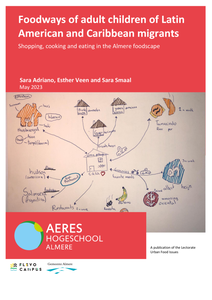Native potato starch is an excellent carrier of minerals due to its inherent ion exchange capacity. Mineral enrichment not only changes the nutritional value but also influences starch pasting and swelling properties. Hydrothermal treatments like annealing constitute a straightforward and green way to tune functional properties. Here, novel combinations of mineral enrichment and annealing were studied. Ion exchange was readily achieved by suspending starch in a salt solution at room temperature over 3 h and confirmed by ICP-OES. Annealing at 50 °C for 24 h using demineralized water or salt solutions strongly affected pasting, thermal, and swelling properties. The obtained XRD and DSC results support a more ordered structure with relative crystallinity increasing from initially 41.7% to 44.4% and gelatinization onset temperature increasing from 60.39 to 65.94 J/g. Solid-state NMR spectroscopy revealed no detectable changes after annealing. Total digestible starch content decreased after annealing from 8.89 to 7.86 g/100 g. During both ion exchange at room temperature and annealing, monovalent cations promoted swelling and peak viscosity, and divalent cations suppressed peak viscosity through ionic crosslinking. The presented combination allows fine-tuning of pasting behavior, potentially enabling requirements of respective food applications to be met while offering an alternative to chemically modified starches.
DOCUMENT
This study provides insights into novel combinations of hydrothermal modifications and mineral enrichment by demonstrating the versatility of this environmentally more benign approach compared to other common chemical starch modifications like crosslinking. Heat-moisture treatment (HMT) (15 % moisture, 100 °C) of native potato starch (NPS) affords granular products that gelatinise at lower temperatures, hold more water as gel, and are more susceptible to enzymatic digestion. Prior mineral enrichment of NPS with sodium, potassium, magnesium and calcium ions yielded significant changes in pasting curves, with monovalent cations increasing peak viscosity, while divalent cations decrease peak viscosity through ionic crosslinking of phosphate groups, allowing further fine tuning of swelling behaviour. Both short and long HMT (4 h and 16 h) triggered partial disruption of crystallinity and an increase in particle size without visible surface damage as evidenced by X-ray diffraction, laser diffraction and scanning electron microscopy. These novel products may find applications where a thickening agent is needed, and high levels of target minerals are desirable like sport nutrition. The viscosity behaviour, available energy and essential minerals may be beneficial to the formulation and nutritional value of energy gels, while adhering to clean-label requirements of today`s food industry.
DOCUMENT
A bacterium belonging to the Bacillus firmus/lentus-complex and capable of growth on native potato starch was isolated from sludge of a pilot plant unit for potato-starch production. Utilization of a crude enzyme preparation obtained from the culture fluid after growth of the microorganism on native starch, resulted in complete degradation of native starch granules from potato, maize and wheat at a temperature of 37°C. Glucose was found as a major product. Production of maltose, maltotriose and maltotetraose was also observed. Native-starch-degrading activity (NSDA) could be selectively adsorbed on potato-starch granules, whereas soluble-starch-degrading activity (SSDA) remained mainly in solution. The use of such a starch-adsorbed enzyme preparation on native starch resulted in a completely changed product pattern. An increase in oligosaccharides concomitant with less glucose formation was observed. An increased conversion of soluble starch to maltopentaose was possible with this starch-adsorbed enzyme preparation. It is concluded that NSDA comes from α-amylase(s) and SSDA from glucoamylase(s) and/or α-glucosidase(s). Cultivation of B. firmus/lentus on glucose, maltose, or soluble starch resulted in substantially smaller quantities of (native) starch-degrading activity.
LINK
Modified starches are used widely in the food industry but often have a low nutritional value, lacking minerals vital for the human body, such as magnesium. Magnesium addition to native starches has been shown to result in changes in pasting properties. However, little work has been done on the addition of magnesium and other divalent cations to highly oxidised starches. In this work, we used dibasic magnesium hypochlorite (DMH) to oxidise potato starch to an industrially relevant degree of oxidation while at the same time introducing magnesium into the starch structure. We found that magnesium incorporation changes the pasting properties of starch and increases the gelatinisation temperature significantly, possibly due to an ionic cross-linking effect. These properties resemble the properties found for heat-moisture-treated potato starches. This change in properties was found to be reversible by performing a straightforward exchange of metal cations, either from sodium to magnesium or from magnesium to sodium. We show in this work the potential of the addition of divalent cations to highly oxidised starches in modifying the rheological and pasting properties of these starches and at the same time adding possible health benefits to modified starches by introducing magnesium.
DOCUMENT
The research sets out to explore what adult children of migrants consider to be their eating culture and food identity. We do so by looking at how they shop, cook, and eat on a daily basis and what foods they feel connected to. A secondary goal of this research is to understand how important sustainable food is for this group. For this report, we invited adult children of migrants, who grew up in Almere to share their stories. Being born in the Netherlands with parents who were born abroad – in our case Latin-America and the Caribbean – children of migrants grow up in two different food environments simultaneously. Outside the home, they are surrounded by a Dutch food environment, while the eating patterns in and around their household or wider family setting may reflect the backgrounds of their parents.
DOCUMENT
